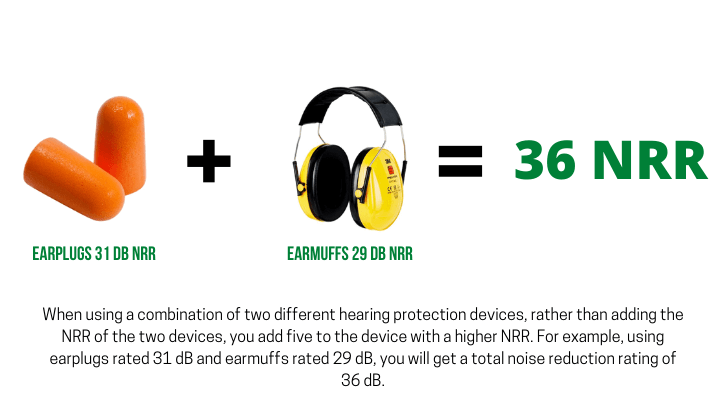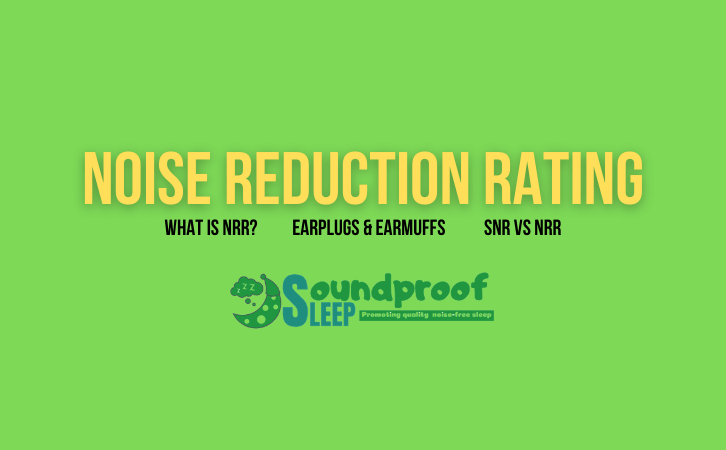Hearing protection devices (HPDs) like earplugs and earmuffs are the best defense to help reduce loud noise levels. If you have bought earplugs or earmuffs, you have probably come across the letters ‘NRR’. What is NRR? How does it affect earplugs and earmuffs? Is a higher NRR rating better? I have answered these questions in this post and much more.
[sta_anchor id=”noise-reduction-rating”]What is NRR?[/sta_anchor]
NRR is short for Noise Reduction Rating, is measuring by the American National Standards (ANSI), and is used to determine how effective a hearing protection device will be against noise. Measured in decibels (dB) NRR ratings apply to only earplugs and earmuffs and are useful to users when comparing different hearing protection devices.
A higher NRR value is better and blocks out more noise than a lower NRR. To receive the maximum protection from a device, whether an earmuff or earplug, it must be worn properly.
[sta_anchor id=”earplugs-and-earmuffs-nrr”]Earplugs & Earmuffs[/sta_anchor]
The NRR ratings labeled on different earplugs and earmuffs do not co-relate to how much noise they will block. For example, if you are in a construction site where the noise exposure is 95 dB, and you are wearing foam earplugs with an NRR 31 dB, the level of noise exposure would not reduce to 64 dB. To get the actual number of decibel deduction you take the NRR rating (dB), subtract seven, and then divide by two.
So, earplugs in the previous example with NRR 31 dB noise reduction would be (31-7)/2 = 12. This means at a construction site with a level of noise exposure at 95 dB, and you are wearing earplugs with NRR 31 Db, your new exposure would be 83 dB.
When using a combination of two different hearing protection devices, rather than adding the NRR of the two devices, you add five to the device with a higher NRR. For example, using earplugs rated 31 dB and earmuffs rated 29 dB, you will get a total noise reduction rating of 36 dB.

Apart from our outlined examples above, NIOSH also recommends derating earmuffs, foam earplugs, and other types of earplugs by a factor of 75%, 50%, and 30% respectively. Check out our guide for the different types of earplugs.
Derating NRR values of different earmuffs and earplugs accounts for the significantly reduced protection provided by different HPDs in real-world conditions.
[sta_anchor id=”snr-vs-nrr”]SNR vs. NRR[/sta_anchor]
SNR stands for Single Number Rating.
The main difference between SNR and NRR is that SNR is a measurement system used within the European Union, while NRR is a rating used in the united states. Both ratings, however, are designed to give an estimate of how effective hearing protection devices would reduce noise when fitted correctly.
The other difference between SNR and NRR is when derating the two values. Health and Safety Executive recommend derating hearing protection devices by 4dB to get the attenuation in real-world conditions. An earmuff with SNR 35 dB would, therefore, be rated 31 dB.
There is no way of converting NRR to SNR or vice versa. However, adding 2 or 3 dB to NRR ratings will give SNR, white minus 2 or 3 from SNR will give NRR as follows:
NRR 31 dB + 2 or 3 = ±SNR 34 dB
SNR 38 dB – 2 or 3 = ±NRR 35 dB
Wrapping Up
Regardless of whether you need hearing protection devices for sleeping, your job, or when you go out shooting or hunting, the NRR rating plays an important part in how well HPDs block out noise. While NRR is an important rating, make sure a pair of earplugs/earmuff is comfortable for you. For better noise-blocking earplugs, check out our picks of highest NRR earplugs you can find on the market.
If you have any questions, please comment below, and I’ll get back to you.

